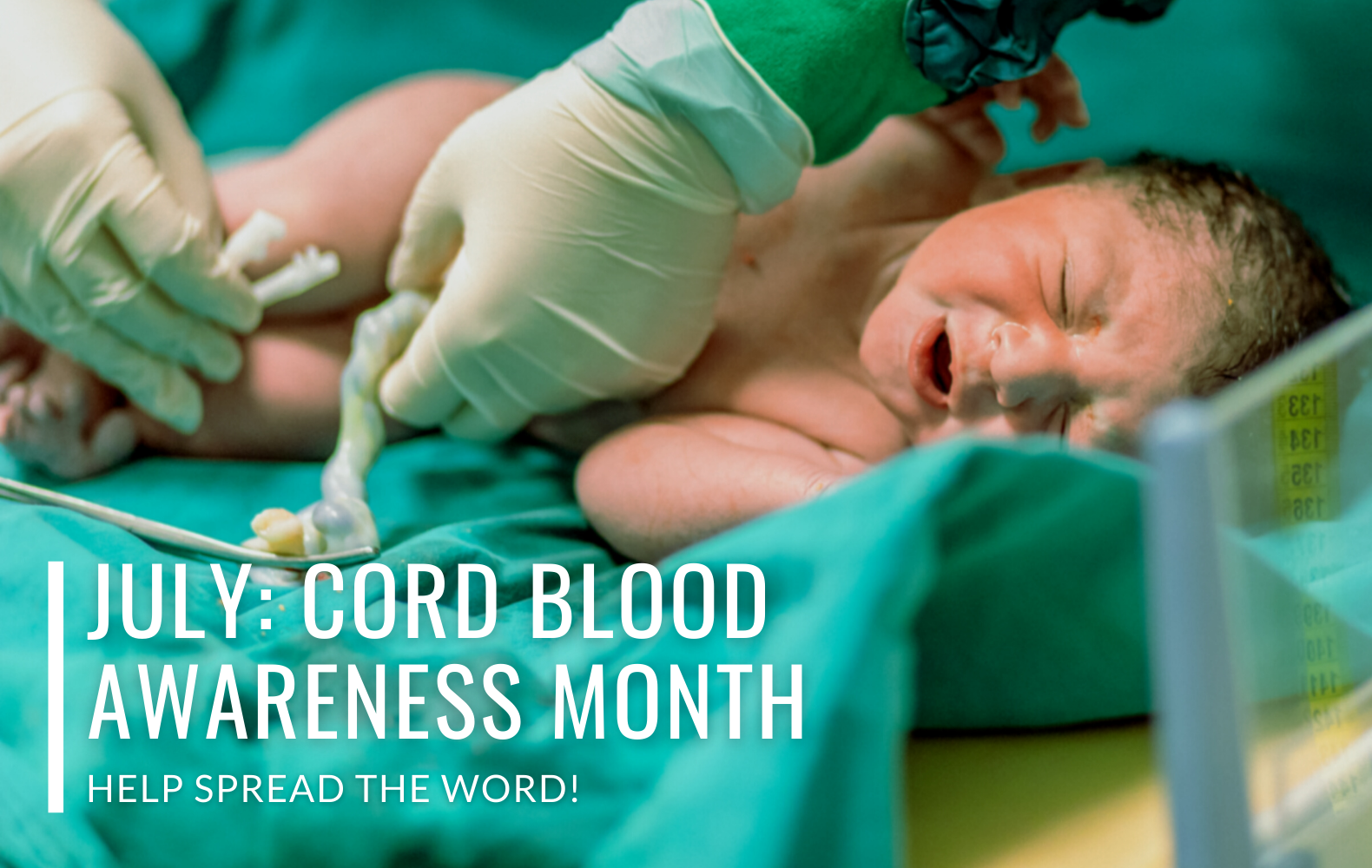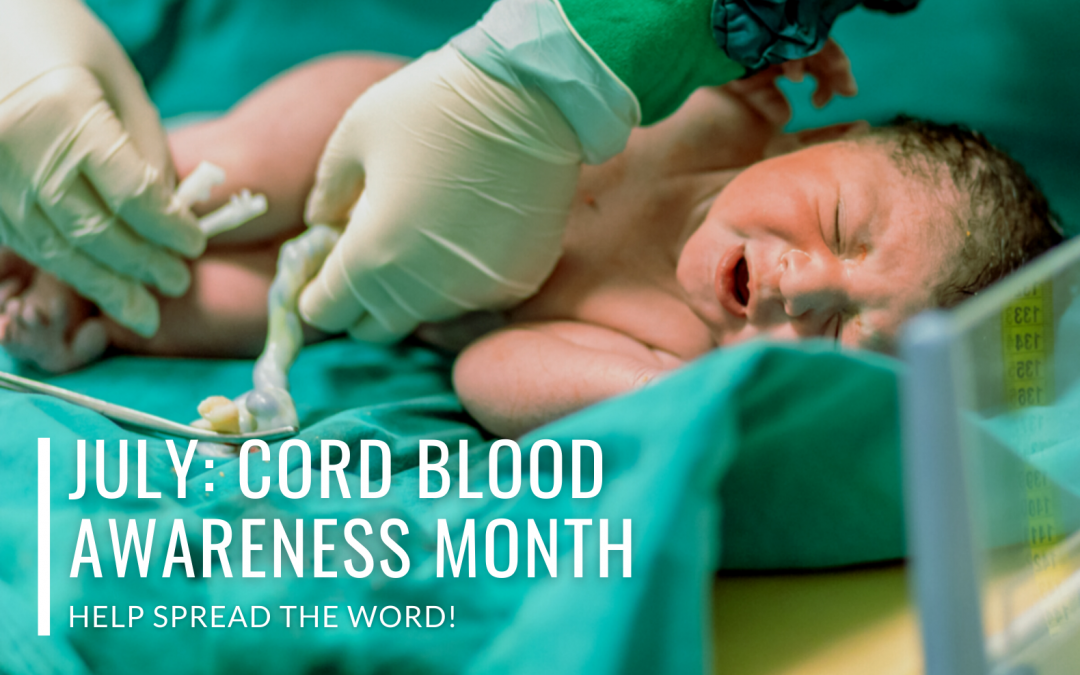
July is Cord Blood Awareness Month, an annual event designed to raise awareness of umbilical cord blood and its many medical applications. The event aims to educate people about the regenerative capabilities of cord blood and the many benefits of storing your child’s umbilical cord blood for later use.
Cord blood stem cells are used to treat over 85 different medical conditions, including many forms of cancer, blood disorders, immune disorders, and metabolic disorders.
There are also dozens of research projects looking at the potential of using cord blood stems to treat conditions like heart disease, blindness, Alzheimer’s disease Parkinson’s disease and paraplegia.
Unfortunately, most parents are not aware of the value of their child’s cord blood. As a result, cord blood is usually discarded as medical waste. A recent study found that of 4 million births occurring annually in the United States, 90% of stem cells contained in cord blood were discarded.
The organisers of Cord Blood Awareness Month hope that their campaign will reduce the amount of cord blood samples being wasted. By informing parents of the therapeutic value of their child’s cord blood, more samples will be stored in cord blood banks for future use.
In this guide, we will share some information about cord blood stem cells and the conditions they can treat. We will also explain how cord blood banking works, to help you understand if it is the right choice for your family.
What Is Cord Blood and What Makes It Special?
Cord blood is the nutrient-rich blood which flows from a pregnant mother’s placenta to her baby via the umbilical cord. It supports the growing foetus by delivering a constant stream of stem cells, growth hormones, oxygenated blood, and other beneficial nutrients.
After the baby is born, the umbilical cord is clamped and cut. At this point, the cord still contains some cord blood, which is packed with powerful regenerative cells.
Normally, the umbilical cord would be discarded as medical waste and these valuable components would be lost. However, after decades of research, we now know that the haematopoietic and mesenchymal stem cells in cord blood can be isolated and used to treat a variety of medical conditions.
The stem cells found in cord blood are particularly valuable because they are young cells with less stringent HLA cell-type matching requirements. They can often be used when there is only partial compatibility between donor and recipient. They are also less likely to trigger graft-versus-host disease.
The medical conditions which can be treated with cord stem cells include:
Blood Cancers
Over the last 30 years, cord blood stem cells have been used to save the lives of thousands of people can be used to treat a variety of blood cancers including:
- Acute Biphenotypic Leukaemia
- Acute Lymphocytic Leukaemia
- Acute Myelogenous Leukaemia
- Ewing Sarcoma
- Hodgkin’s Lymphoma
- Multiple Myeloma
- Neuroblastoma and more
Blood Disorders
There are dozens of blood disorders with severe symptoms. Some of these conditions can also increase the risk of other life-threatening diseases occurring, like cancer. Some of the blood disorders treatable with cord blood include:
- Aplastic Anaemia
- Fanconi Anaemia
- Sickle Cell Disease
- Severe Combined Immunodeficiency
- Cooley’s Anaemia and more
Immune System Disorders
The haematopoietic stem cells in umbilical cord blood can be used in conjunction with other treatments to ‘reset’ the immune system and treat some immune disorders like:
- Cartilage-Hair Hypoplasia
- Gunther’s Disease (Erythropoietic Porphyria)
- Hermansky-Pudlak Syndrome
- Pearson’s Syndrome
- Shwachman-Diamond Syndrome
- Systemic Mastocytosis
Metabolic Disorders
Cord blood stem cells can be used to restore healthy metabolic function. Some of the types of metabolic disorders treatable are:
- Hurler Syndrome (MPS-IH)
- Hunter Syndrome (MPS-II)
- Morquio Syndrome (MPS-IV)
- Krabbe Disease (Globoid Cell Leukodystrophy)
- Scheie Syndrome (MPS-IS)
- Sanfilipp Syndrome (MPS-III)
- Metachromatic Leukodystrophy
- Lysosomal Storage Diseases and more
Potential Uses for Cord Blood Stem Cells
There are dozens of clinical trials and studies into the use of cord blood stem cells. Several of these research projects have shown very promising results, suggesting that more cord blood stem cell treatments will be available in the future. Some of the conditions which could someday treated with cord blood stem cells include:
- Alzheimer’s Disease
- Autism
- Cerebral Palsy
- Hearing Loss (Acquired Sensorineural)
- Parkinson’s Disease
- Spinal Cord Injury
- Stroke
- Traumatic Brain Injury
- Diabetes
- Acute Myocardial Infarction (Heart Attack)
- Cartilage injuries
- Stoke
- Osteoarthritis
- Lupus
What Is Cord Blood Banking?
Cord blood banking is the process of collecting and storing umbilical cord blood for later use.
After your child has been safely delivered and the umbilical cord has been detached, a phlebotomist removes the remaining blood inside the umbilical cord. The cord blood sample is immediately sent to a laboratory for processing, testing, and cryogenic storage.
Parents retain complete control over their child’s cord blood and can withdraw it from the bank whenever it is needed (more on how the process works below).
Facts On Cord Blood Banking
Here are some facts relating to cord blood banking to help you understand its growing importance:
- The world’s first cord blood transplant for treating leukaemia occurred in 1990.
- In 1998, a groundbreaking study was released which proved the viability of cord blood stem cells. Since then, cord blood programs have seen a massive increase in donations.
- About 27% of cord blood transplant recipients are 18 or older.
- 7% of all transplants are used to treat leukaemia.
- Children with leukaemia who receive cord blood stem cells have a 20% higher rate of survival compared to children who receive matched bone marrow stem cells.
- In the USA, the odds of a child needing a cord blood sample by the time they are 20 is about 1 in 5,000. If a siblings cord blood is also considered, that drops to 1 in 2,500.
- There have now been over 40,000 stem cell transplants worldwide, using cord blood from both private cord blood banks and donors.
Why Do Parents Save Cord Blood?
Parents save their child’s cord blood to protect their child against life-threatening diseases. Having an autologous stem cell sample (a person’s own stem cells) available may someday help their child survive if they are diagnosed with leukaemia or another serious illness.
Having a cord blood sample available may also be useful for treating injuries sustained by their child. There is research to suggest that cord blood stem cells may be used to treat spinal injuries, burn injuries, and brain injuries in the future. If an accident does happen, having autologous stem cells available could help them recover more easily.
Another common reason why parents are storing cord blood is to create a medical resource which can used by the rest of the entire family. A child’s stem cell sample has a 25% chance of being an exact match with a sibling and a 50% chance of being a half match.
This means that saving one child’s stem cells may save the life of another. There is also a high chance that the sample will be compatible with parents and grandparents.
For example, given the recent research into the use of stem cells for neurodegenerative diseases, there is a distinct possibility that a child’s stem cells could someday be used to treat a parent’s or grandparent’s Alzheimer’s disease.
How Cord Blood Banking Works?
1. Initial contact cord blood bank
Parents will make initial contact with a cord blood bank to discuss their options. Most private blood banks offer several services including cord blood storage, umbilical cord tissue storage, placental cells storage, and amnion storage. Parents can also choose if they want their child’s cord blood stored in multiple locations.
Once a plan has been chosen, the cord blood bank will gather some information from the client. This includes their name, address, phone number, and the hospital where the delivery will occur.
2. Cord blood collection kit delivery
The cord blood bank will deliver a collection kit to the parent which they need to bring to the hospital on the day of delivery. This kit contains everything that is needed to collect and transport the umbilical cord blood to a laboratory for processing.
3. Cord Blood collection
Once your baby has been safely delivered and the umbilical cord is detached, a doctor, nurse, or qualified phlebotomist will sanitise the umbilical cord and drain its blood into a container. If the umbilical cord tissue is being stored, they will also collect it. A courier will then collect the samples and immediately transport them to a laboratory for processing.
4. Cord Blood Processing and Storage
The cord blood sample will be analysed to determine how many stem cells it contains. It will also be checked for contaminants. If it is viable, it will be processed before being cryogenically frozen.
5. Cord Blood Usage
Once frozen, cord blood stem cells can last decades. When you require access to your cord blood sample, you will need to contact our facility directly and it will be released for use.
Sources
https://www.brmsonline.com/blog/wellness/2018/cord-blood-awareness-month
https://healthresearchfunding.org/19-incredible-cord-blood-transplant-statistics/
https://blog.medcells.ae/blog/umbilical-cord-blood-a-history-of-clinical-use
https://en.wikipedia.org/wiki/Hematopoietic_stem_cell
https://cells4life.com/cord-blood-banking-overview/stem-cell-treatments/
https://pubmed.ncbi.nlm.nih.gov/28928957/
{{cta(‘7d7cc8da-ed20-48a8-8ef3-e2429767260f’)}}

